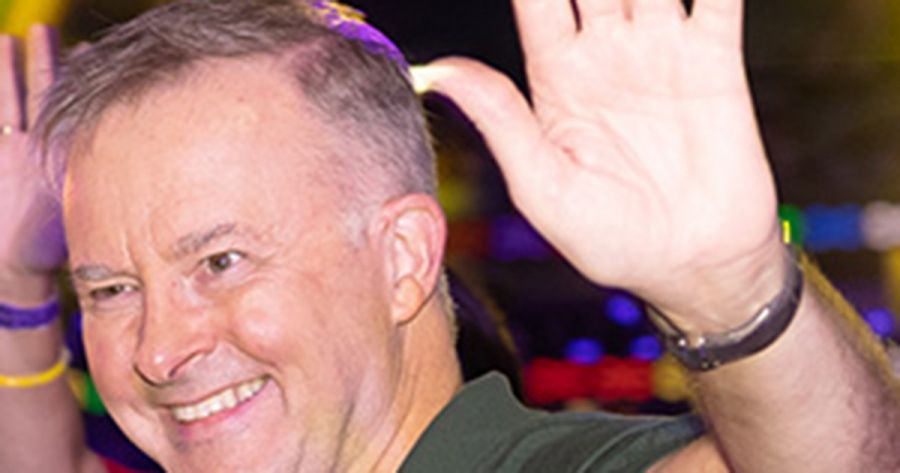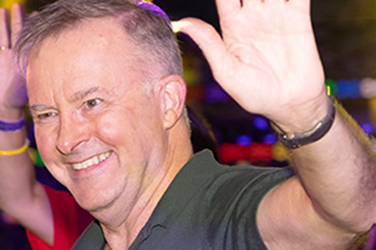
- Free Article: No
- Contents Category: Commentary
- Custom Article Title: A revival meeting at the Espy
- Review Article: Yes
- Article Title: A revival meeting at the Espy
- Article Subtitle: Labor’s new National Cultural Policy
- Online Only: No
- Custom Highlight Text:
Policy announcements are a peculiar kind of theatre, and Labor’s launch of its new five-year arts plan, Revive, was a strong example of the genre. It was held at Melbourne’s iconic Espy in St Kilda, a venue where arts audiences were treated to words of encouragement from Minister Tony Burke on his speaking tour to spruik the submissions process in 2022, and where ‘DJ Albo’ once entertained a modest crowd.
- Featured Image (400px * 250px):

- Alt Tag (Featured Image): Jennifer Mills on the National Cultural Policy
The prime minister skipped the internally divisive parts of that legacy, describing his own era as ‘a political culture of building common ground’. Tellingly, he also explicitly sought to recruit artists and arts workers to the Voice campaign, perhaps the first great test of his leadership. In doing so, he acknowledged the power of arts and culture to strengthen positive messaging and national unity. Artists’ fortunes might rise and fall with the whims of governments, but they need us at least as much as we need them.
Burke, a seasoned performer and a charming speaker, let the emotional affect show, as Albanese often does. He, too, made claims of unity, of ‘the culture wars disappearing in cultural policy’. But Revive is a firmly Labor policy, and the arts remains intensely partisan. Burke’s personal passion for the arts is both good and bad for a sector that has been traumatised by successive ministerial whims. Music and literature have been neglected, but they may also be getting more attention simply because Burke enjoys them. The announcement that Australia will appoint a poet laureate from 2025 was clearly overdue, but it was also performative: an emotive, highly visible gesture that will pay dividends in good optics.
For at least a decade, arts advocates have had to choose between two forms of value: the warm, fuzzy aura of intangible social benefit and the cold hard numbers of economic worth. Burke made it clear that these two facets should not be in competition. He emphasised both cultural value and economic contribution. ‘You touch our hearts and you are a $17 billion industry,’ he told the room, emphasising the conjunction. ‘You are entertaining and you are essential.’ As the poet did in Holland-Batt’s moving poem, ‘The Gift’, I hated myself for noticing Burke’s poetry, for enjoying and being moved by the repetitive phrasing. There is such a thirst for statements like Albanese’s ‘arts jobs are real jobs’, or Burke’s ‘you are essential workers’, you could almost hear the dust hiss as they landed. Intangible things do matter: worth, care, value, meaning. But you can’t live on that stuff alone.
A policy launch might be performance art, but policy is also architecture. Fortunately, Revive goes some way to constructing a much-needed material transformation in the arts. Restoring funding to pre-2013 levels to the rebranded Creative Australia (the Australia Council name will remain only in reference to the Board) is a great start, though, as Alison Croggon has pointed out, the new annual budget of around $250 million will remain slightly lower than the $220 million budget of 2013 when adjusted for inflation. Much more money is needed to bring a sense of security to the sector’s long-suffering practitioners and small-to-medium ecosystem. And more is expected from the new organisation, with four new bodies to be set up under its umbrella: a First Nations body to ensure autonomy and resourcing of First Nations arts; a Centre for Arts and Entertainment Workplaces, which will manage pay rates, codes of conduct, and workplace safety; Music Australia, to be set up this year to administer funding and advocate for musicians and the music industry; and Writers Australia. There is $19.3 million earmarked for Writers Australia. This represents a welcome allocation, with little detail about distribution. Nerves are frayed by previous failures like the Book Council of Australia and Writing Australia. Scheduling Writers Australia’s implementation to coincide with the next federal election runs the risk of inflicting another self-destructing gift on the literary sector. However, lasting change takes time, and Burke has promised further consultation.
For published writers, the only immediate change to our incomes is likely to come from the introduction of Digital Lending Rights (DLR), which will expand the existing Lending Rights scheme to include eBook lending from public libraries. DLR is funded to the tune of $12.9 million for the first four years and $3.8 million a year thereafter. DLR is the low-hanging fruit that has taken many years to pluck, a result of long advocacy from the Australian Society of Authors and many others, with strong support from libraries and the Australian Library and Information Association (ALIA). According to the ASA’s latest report, authors average $18,200 a year from their creative work; lending rights contribute ten to twenty per cent of this, and currently provide some income to more than 10,000 writers. EBooks can stay in circulation longer than paper books and are accessible to a more diverse range of readers. With eBook lending accounting for an increasing proportion of library loans, it is past time that the scheme caught up with changing readerly habits.
Taken together, DLR and Writers Australia are the two most significant investments in Australian literature in decades. Literature has been under-served by the Australia Council, often bearing the brunt of funding cuts from which major organisations and other sectors have been protected. There is little institutional support to promote reading or Australian writing. The Australia Council currently spends less than seven per cent of its overall funding budget on literature, with only $1.8 million in project grants distributed to just forty-five authors and organisations last year. The scarcity has resulted in some shocking decisions, such as the notorious 2021–24 funding round, when only one literary journal received funding (it wasn’t ABR).
In the 1970s and early 1980s, with a population half the size, there were a hundred such grants a year, many of them fellowships equivalent to the average wage. Labor has a long way to go before it approaches Gough Whitlam’s legacy.
Two other changes will have an impact on writers’ lives, eventually. The first is the promise of conditional funding on fair pay and other conditions, with pay rates for artists and writers to form part of the Review of Modern Awards later this year. The second is a gesture towards something that was not mentioned in Creative Australia: the consideration of creative work under mutual obligation, potentially making practising artists and writers eligible for unemployment benefits.
The latter is a mere suggestion at present (with a promise to ‘develop information’ about the idea), but the former is a significant and welcome shift in approach, with the new Centre for Arts and Entertainment Workplaces set up to administer fair pay, minimum rates, and workplace safety. The Centre will provide advice, develop codes of conduct, and ‘refer matters to the relevant authorities’ – presumably with an overhaul to Fair Work also in sight. This will include the adoption of the National Association for the Visual Arts (NAVA) code of practice in the visual arts, and consideration of ASA and Media, Entertainment and Arts Alliance (MEAA) freelance rates. For the first time, we have a commitment to making arts funding conditional on fair pay.
Conditional funding will be transformative – if it can be achieved. At present, impoverishment is the norm in literature, a field that relies heavily on unpaid and underpaid work. If every publication that receives funding has to pay industry standard rates, total funding will have to rise significantly. It is understandable, then, that Writers Australia will not be established for two years; there is much detail to consider, and organisational budgets will need time to catch up.
Writers Australia will also be responsible for directly funding writers, conducting research and advocacy, determining the Prime Minister’s Literary Awards (no longer subject to prime ministerial intervention), and appointing the poet laureate. Like Creative Australia as a whole, it will be expected to work across public, commercial, and philanthropic streams. It will have to balance the demands of publishers, authors, readers, and institutions fairly; there will be questions about its independence and the power differentials inherent in these relationships. Structural change is expensive, so it’s unlikely that there will be a significant increase in grant funding to writers in the short term.
When Revive was announced, many arts organisations were finalising their expressions of interest for the 2025–28 funding round. Budgets may not have been affected by the proposed changes, but the eternal flux of policy is unsettling, and even good news can be destabilising. When the relief and celebration die down, few in the arts will find that they can muster the confidence that Labor seems to have in its own longevity.
To have a policy of any kind so soon after the election is encouraging, and this one has more detail than many were expecting. It is hoped that the May Budget will bring further relief and greater detail, with the National Library’s Trove and the National Archives under particular threat, both essential resources for the creation and preservation of literary works. Importantly, Revive begins with an understanding of the inherent value of arts and culture. It acknowledges that ‘culture permeates every facet of the human activities and economies which it is government’s role to enable, manage, and regulate’, and reiterates the need for a whole-of-government approach.
In an encouraging attempt to break what has become a mendicant mindset in the arts, Burke left his audience not with an expectation of gratitude, but with a carefully pitched invitation to make a contribution. ‘Over to you, typewriters loaded, a blank page ready to write the next chapter,’ he said, sounding like someone’s dad at a graduation dinner. Missy Higgins sang the outro: a stirring version of The Triffids’ ‘Wide Open Road’. It was a calculated blend of nostalgia and possibility. Albanese had his picture taken with Higgins, then turned for a selfie with the crowd. The photos were up on his socials within the hour, and we were left blinking in a sudden stillness, bodies still braced against the wind.
This article, one of a series of ABR commentaries addressing cultural and political subjects, was funded by the Copyright Agency’s Cultural Fund.



Comments powered by CComment